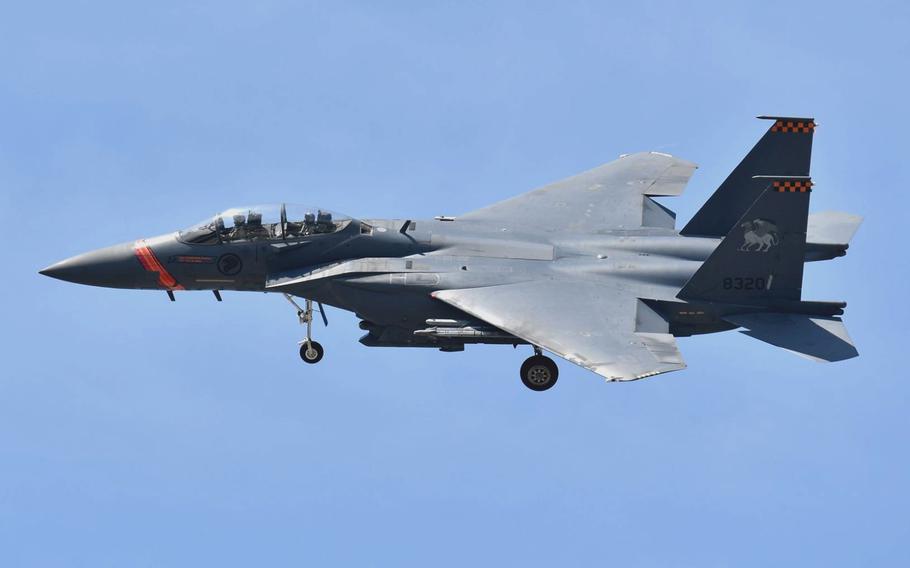
A Singaporean F-15SG photographed in flight May 13, 2020. (Singapore air force)
The U.S. Air Force is considering a plan to base up to 12 Singaporean F-15SG Eagle fighters on Andersen Air Force Base, Guam, according to recent announcement by the Department of the Air Force.
The 36th Wing at Andersen would need a new hangar and more ramp space to accommodate the Singapore Eagles, along with maintenance and other support facilities, fuel systems, earth-covered ammunition storage and other infrastructure, according to the Dec. 13 announcement posted on Andersen’s official website.
The new facilities would be built on 209 acres over three to seven years and could also support other U.S. or foreign units. The site under consideration is in a munition storage area near the northwest corner of the airfield, according to the announcement.
The project would provide critical infrastructure that enhances U.S. posture west of the International Date Line, support American and friendly forces and “strengthen the U.S.’s ability to respond regionally and worldwide,” the announcement said.
The Air Force did not respond to emailed questions Thursday about how much the project might cost or who would fund it.
In 2019 Singapore and the U.S. signed a memorandum of understanding on the establishment of a fighter training detachment on Guam, according to a Dec. 24 statement on Singapore’s Ministry of Defence website.
“Overseas training detachments are integral to meeting the RSAF (Republic of Singapore Air Force) training requirements,” the statement said. “The access to vast airspace overseas allows the RSAF to overcome local airspace constraints, and conduct high-end, realistic training to hone its operational competencies.”
Aviation facilities on Andersen for U.S. Marines assigned to the nearby Camp Blaz are still under construction. Meanwhile, Gen. Kenneth Wilsbach, commander of Pacific Air Forces, revealed plans to restore a World War II-era airfield on the nearby island of Tinian in a Dec. 13 interview with Nikkei Asia.
The plan to accommodate the Singapore jets comes during the departure of two Air Force F-15C/D squadrons, nearly 50 fighters, from Kadena Air Base, Okinawa. The jets are being phased out over two years and replaced by rotating squadrons of aircraft from as far away as Germany and Alaska.
The proposal to base Singapore’s F-15s on Guam is not directly related to changes to U.S. fighters on Okinawa, retired Air Force Lt. Gen. Dan Leaf, a former deputy commander of U.S. Pacific Command, said Friday.
“It is another example of the broadening of U.S. partnerships in the Indo-Asia Pacific Region,” he said in an email.
China accuses the U.S. of creating a “Cold War mindset” but the move to accommodate the Singapore jets on Guam is another case where a nation is drawn to America as a security partner due to concerns about China’s “intent, rhetoric and aggressive actions,” Leaf said.
“While Singapore AF pilots have trained in the U.S. for decades, joint basing at a U.S. installation in the region is another level of cooperation,” he said. “It will contribute to overall readiness for Singapore, interoperability on the ground and in the air, and increased flexibility in basing.”
Interoperability for the U.S. military refers to the ability of one nation to make use of another nation’s military equipment and training methods.
The Air Force will survey cultural and natural resources in the areas on Andersen earmarked for upgrades and decide on the project in early to mid-2025, according to the service’s announcement.